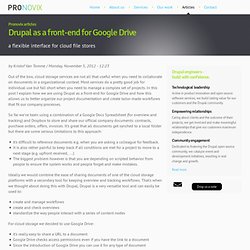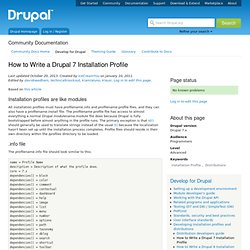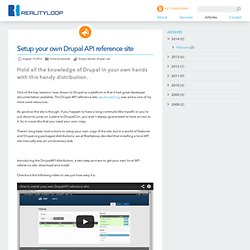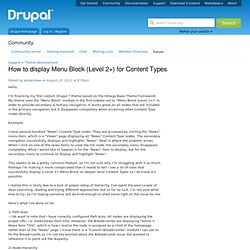

Drupal as a front-end for Google Drive. Out of the box, cloud storage services are not all that useful when you need to collaborate on documents in a organizational context.

Most services do a pretty good job for individual use but fall short when you need to manage a complex set of projects. In this post I explain how we are using Drupal as a front-end for Google Drive and how this allows us to better organize our project documentation and create tailor-made workflows that fit our company processes. So far we've been using a combination of a Google Docs Spreadsheet (for overview and tracking) and Dropbox to store and share our official company documents: contracts, purchase orders, offers, invoices. KahThong.com - Specialist Webmaster, PHP Web Developer, Drupal Theme, Module, E-Commerce, Web Application Developer from Kuala Lumpur, Malaysia. I had another request to alter the default taxonomy_term_data table and adding the timestamps; created and changed just like in the node database table.

Here's a little snippet that will do the trick. How to Write a Drupal 7 Installation Profile. Based on this article.

Installation profiles are like modules All installation profiles must have profilename.info and profilename.profile files, and they can also have a profilename.install file. The profilename.profile file has access to almost everything a normal Drupal modulename.module file does because Drupal is fully bootstrapped before almost anything in the profile runs. The primary exception is that st() should generally be used to translate strings instead of the usual t() because the localization hasn't been set up until the installation process completes. Profile files should reside in their own directory within the /profiles directory to be loaded. Text Formats 101: How Drupal filters work. Drupal’s text formatting and filtering system is one of its most critical components.

The system performs dual duty by both providing features to make content editing for the web both more secure, by allowing us to filter out dangerous HTML tags and such from content posted by untrusted users, and more approachable, by allowing mere mortals to avoid entering content in pure HTML encoding and doing the necessary conversions when necessary. Despite its importance, the system tends not to get much hype or limelight when Drupal is discussed.
An unglamorous workhorse, text formats are designed to be something that you set and then forget. Yes, even if you use it every day, the filtering system can be easy to forget about. Using rules for signup notifications. CCK Signup is a fun module that is very drupal in the sense that it really just extends a bunch of modules you may already have.

Here’s a brief tutorial on using Rules to handle some basic notifications. Learn Drupal with Drupal videos and website development tips by Shane Thomas. Hide submit button when a fieldset is collapsed. How to override front page node tpl - drupal. Setup your own Drupal API reference site. Post date: August 13 2012 Tags:

How to display Menu Block (Level 2+) for Content Types. Hello, I'm finalizing my first custom Drupal 7 theme based on the Omega Base Theme framework.

My theme uses the "Menu Block" module in the first sidebar set to "Menu Block (Level 2+)" in order to provide secondary & tertiary navigation. It works great on all nodes that are included in the primary navigation, but it disappears completely when accessing other Content Type nodes directly. Example: Fun with Fonts. Modules are the workhorses of a Drupal site.

Most are useful, some are essential, but there aren't many that qualify as fun. This tutorial is about one of those rare modules that is actually a real good time, @font-your-face. For many years there were only about a dozen web safe fonts that you could use on your site. In retrospect, it was very boring. In the past couple years, however, things have completely changed. Getting Started. The Formula for an Amazing Drupal Website. There is a lot that goes into creating a great website.

Some of us are good at one or two of these things, others are strictly specialists and some of you reading this are just getting started. After working for over 12 years designing and building websites, I still haven't mastered all the skills needed to turn a website truly golden, as it seems the learning never really ends. However, I have got hold of the basic formula. Over time, I have also come to understand that you can't do it all by yourself. If you try, you will most often end up doing something you have little aptitude for, don't enjoy and won't be able to successfully accomplish. Drupal - A very simple plugin to help develop with Drupal. Drupal Development using Sublime Text 2 in 5 Steps. Tags: drupal planet, drupal, IDE Realityloop love Sublime Text 2, it's super fast and as feature rich as many expensive commercial IDE's, but there's no question that it needs a little attention to make the out of box experience an ideal working environment.

Monitor Everything IT: Website, Server, Application, Network. 100% Free!Monitor Everything IT: Website, Server, Application, Network. 100% Free! Custom Sort Drupal Content with the Draggable Views Module. In the world of sorting, sometimes 'newest first' or 'oldest first' just doesn't cut it. During a recent Drupal project, we had a client who wanted to be able to control the order of their marquee images in random ways via a drag and drop interface.
Enter the Draggable Views module. In about thirty minutes, I was able to set up custom drag and drop functionality for several content types on their site. Drupal 7 Tutorials. Working with the Drupal Computed Field Module. When setting up content types on a more involved site, a developer could easily end up with having an enormous list of fields in one single content type. When this happens, I tend to pause for a second, and think through whether there is any way to consolidate that list. Chances are, I find a field or two whose values either depend on other fields or can be generated without user input. These are the exact scenarios where the Computed Field module can be a great choice. New series: Display Suite for Drupal 7. This week we're happy to announce a free series about Display Suite. This series, Display Suite for Drupal 7, was recorded by the maintainer of the Display Suite project, Kristof De Jaeger, also known as swentel in the greater internets.
As the project page explains, Display Suite allows you to take full control over how your content is displayed using a drag and drop interface. Arrange your nodes, views, comments, user data, etc. the way you want without having to work your way through dozens of template files. What this means is that you can control the layout of all the individual bits and pieces on your site without having to dive into theming or custom code. We are republishing Kristof's great videos here, and we're starting off with the first three of the 11-part series: We'll be releasing the rest of the series over the next few weeks, and we hope you're as excited as we are. Form inside a block in drupal 7. JQuery and JavaScript Theming Tips for Drupal 7. I often see posts on the drupal.org forums and elsewhere in regard to implementing jQuery scripts and code into Drupal. It seems common that users try to attach JQuery right within page.tpl.php or html.tpl.php.
How can I have two different work flows in only one content type. Views Filter Populate – Search Title and Body of nodes in one exposed filter. Elegant CSS In Drupal—LESS vs Sass. Drupal is not a CMS. Creating an Easy Print Button on Drupal Webforms. De-Drupalizing The Login Form. The Absolute Beginner's Guide to Drush.
Creating a local server in Ubuntu. General and Blogs. Jeff's Handy Dandy Drupal Login Bookmarklet. How to add Javascript in Drupal 7 with jQuery. I thought this would be an easy one. Not so. Drupal Performance Tuning ++ CMS Quick Start Drupal Blog. Tutorial Videos. A Simple Progress Bar in Drupal Using CSS. Git. Modules.